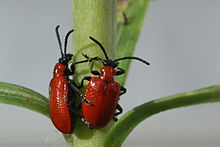| Leaf beetles | |
|---|---|

| |
| Scarlet lily beetle Lilioceris lilii in Oxfordshire, UK | |
| Scientific classification | |
| Domain: | Eukaryota |
| Kingdom: | Animalia |
| Phylum: | Arthropoda |
| Class: | Insecta |
| Order: | Coleoptera |
| Superfamily: | Chrysomeloidea |
| Family: | Chrysomelidae Latreille, 1802 [1] |
| Subfamilies | |
|
See text | |

Leaf beetles are the family Chrysomelidae. There are over 35,000 species in more than 2,500 genera, so it is one of the largest and most common of all beetle families. Many subfamilies are recognized.
Leaf beetles have a tarsal formula which appears to be 4-4-4, but is actually 5-5-5.[2] Some are difficult to tell from long-horned beetles (family Cerambycidae): it is done by the antennae not arising from frontal tubercles.
Adult and larval leaf beetles feed on all sorts of plant tissue. Their diversity has run parallel with that of the Angiosperms.[3] Many are serious pests of cultivated plants, for example the Colorado potato beetle (Leptinotarsa decemlineata), the asparagus beetle (Crioceris asparagi), the cereal leaf beetle (Oulema melanopus), and various flea beetles. A few act as vectors of plant diseases. Others can be used as biocontrol of invasive weeds. Most Chrysomelidae are conspicuously coloured, often in glossy yellow to red or metallic blue-green hues. Some (especially Cassidinae) have spectacularly bizarre shapes. They are highly popular among insect collectors.